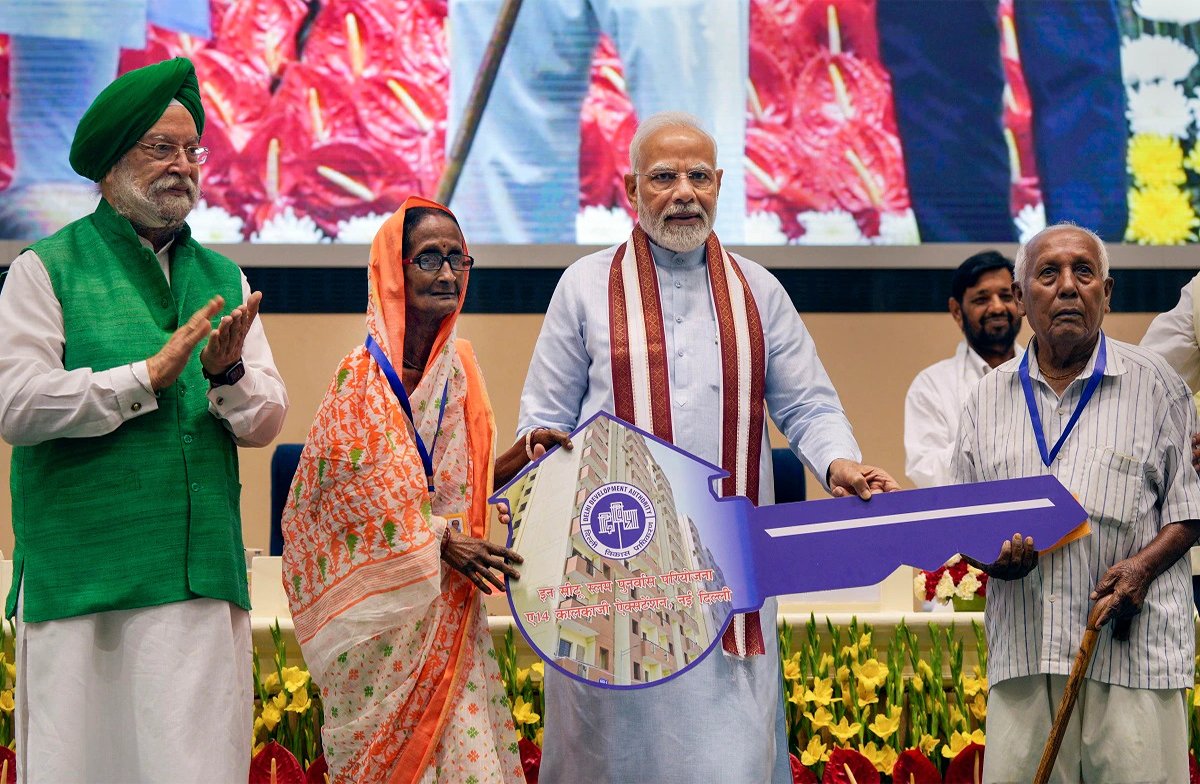The cost of construction of each of the flats allotted on Wednesday to eligible households under the government’s in situ rehabilitation of Bhumiheen Camp’s slum dwellers in New Delhi is nearly ₹ 11.41 lakh, and the beneficiaries are paying “only 10 per cent” of that amount, the DDA said.
The urban body also said that allotment is on a “leasehold basis with a lock-in period of 10 years,” i.e., the property is not transferable for a period of 10 years by the allottee.
Prime Minister Narendra Modi on Wednesday inaugurated 3,024 newly constructed Economically Weaker Section-category flats in Delhi as part of the in situ slum rehabilitation project.
According to information provided by the Delhi Development Authority (DDA), the Bhoomihin camp project is part of the first phase of the Kalkaji in situ rehabilitation project helmed by the DDA, first large-scale in situ rehabilitation project of Delhi.
The first phase spans an area of 3.068 ha, it said.
The eligible JJ dwellers of Bhumiheen Camp (on 2.046 ha of land) will be rehabilitated in these flats, the DDA said.
There are four building blocks having stilt level plus 14-storey reinforced cement concrete or RCC-framed structure. Each flat is of 25 sq m carpet area having two rooms, kitchen, toilet and bathroom with all civic amenities. The flat is finished with vitrified floor tiles, ceramics tiles, Udaipur green marble counter in kitchen.
The cost of construction of each flat is approximately ₹ 11.41 lakh, excluding land cost.
DDA is allotting these flats at a symbolic contribution of ₹ 1.42 lakh, including a maintenance cost of ₹ 30,000 for five years. The beneficiaries are paying only 10 per cent of cost of the construction. The remaining cost has been borne by the DDA, it said.
An amount of ₹ 345 crore has been spent for construction of the 3,024 flats.
Also, allottees will have to “take individual water and electricity connections from power company (BSES) and Delhi Jal Board, and they can avail Delhi government subsidy scheme,” the DDA said.
A senior DDA official said, “Today, we have provided possession letters along with NOCs to all the 575 families who have completed all formalities. They can use that NOCs to apply for water and electricity connections in their names”.
As many as 2,891 households (JJ families) were there at the Bhumiheen Camp. And, 1,862 households have been found eligible. The remaining were “not found eligible for rehabilitation according to the eligibility policy of the DDA,” it said.
However, in order to address grievances of such persons who have been found ineligible by the Eligibility Determination Committee (EDC), there is an appellate authority, constituted by the DDA under retired additional district and sessions judge, with other members, and aggrieved slum-dwellers can file an appeal against the decision of the EDC, the official said.
Till date, full payment from 1,000 families have been received. Requisite documents for issue of possession letters are being completed, he said.
Valid documents include, water and electricity bills, Aadhaar cards showing their place of residence in the camp, and the cut-off period we have given is January 1, 2015, the official said.
Among the facilities, a dedicated STP (sewage treatment plant) and dual pipeline facility is in the entire complex. And, treated water is to be used for flushing in toilets or for horticultural purposes, it said.
A site of 1,000 sq m has been earmarked for development of a facility centre. This centre shall be developed to provide necessary level of services and community facilities for residents, such as healthcare community hall, ‘Basti Vikas Kendra’, police post ‘aanganwari’, retail outlets and religious places, the urban body said in a statement.
Other public amenities, include community parks (‘tot-lots’), dedicated electric sub-stations, lifts, underground reservoir for hygienic water supply, it said.
A plot for senior secondary school (2,000 sq m) and primary school (800 sq m) is being provided.
Once encroached site of Bhumiheen camp gets vacated after rehabilitation under phase-I, the vacated land and the land encroached by remaining two JJ clusters, namely Jawaharlal Camp and Navjeewan camp will be utilised for rehabilitation of the balance two clusters under a PPP project, the DDA said.
According to 2011 census, 10.63 per cent of the population live in slum, occupying only 0.5 per cent of city area. A survey of the Delhi Urban Shelter Improvement Board (DUSIB) shows there are 675 identified Jhuggi Jhopri (JJ) clusters in Delhi.
According to an estimate about 1.72 lakh households (families) are residing in these (376) clusters. The inhabitants in these clusters live in unhygienic and unplanned conditions with lack of public amenities and facilities, it said. In order to provide a better and healthy living environment to the residents of these JJ clusters, the DDA has been undertaking in situ rehabilitation projects in terms of provisions stipulated in MPD 2021. There are three ongoing projects for in situ rehabilitation of slum clusters, at A-14, Kalkaji Extension; Jailorwala Bagh, Ashok Vihar; and Kathputli Colony, Shadipur.
As many as 1,675 EWS-category houses are under construction at Jailorwala Bagh on a vacant DDA land near to the JJ cluster namely Jailorwala Bagh. And, 2,800 EWS-category houses are under construction at a redevelopment site in Kathputli Colony, Shadipur, it said.

























